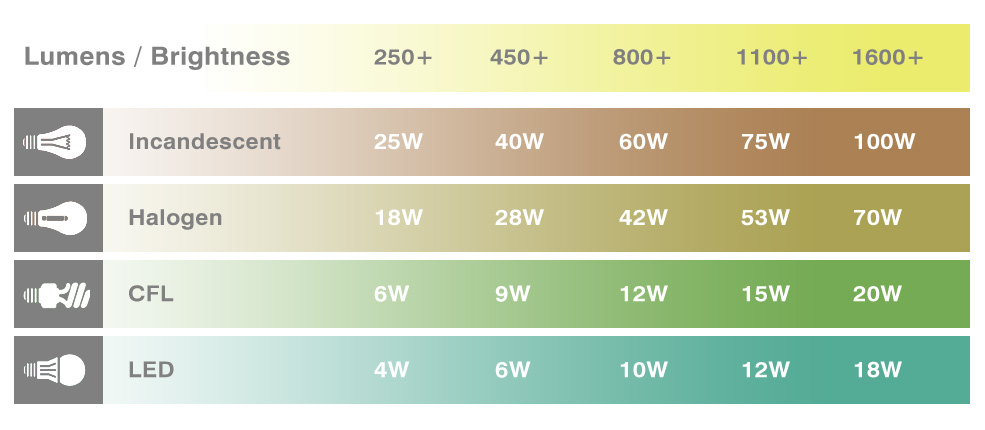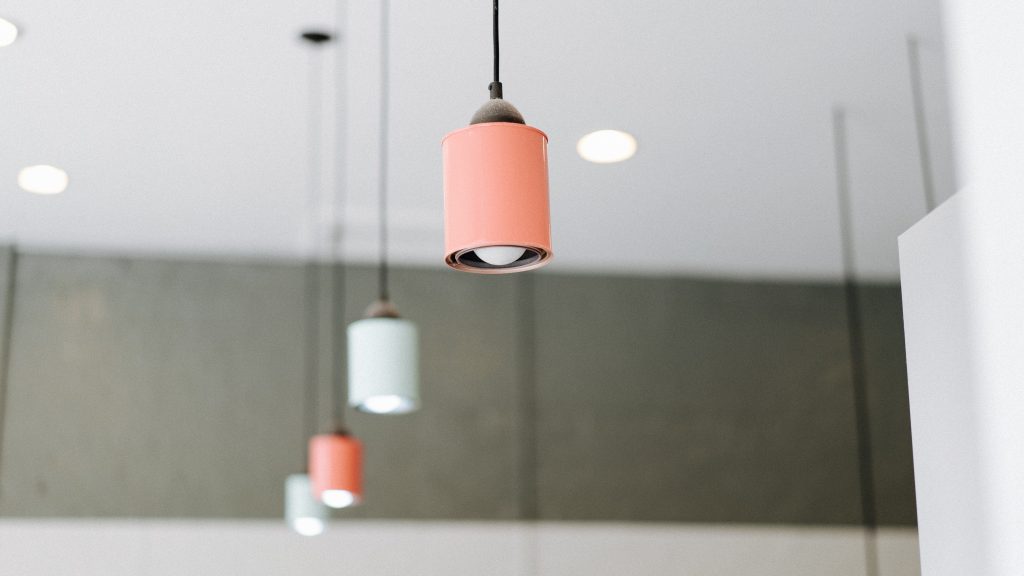Lighting is often a big part of our electricity bill, and often one of the things you can save a lot of money on!
In this article I will explain what the different kinds of light bulbs are, what they do and how they can save you a lot, without compromising. In some cases, it will even be an improvement!
The costs
We get billed by kWh, which means a 1000 watt per hour. So, if say, a heater is 2000 watt, that means it uses 2000 watt in one hour. On average 1 kWh costs about 25 cents. To run that heater for an hour would be around 50 cents (2000 watt / 1000 * $0.25). To run a traditional light bulb (e.g. 75 watt) for an hour would be 2 cents (75 watt / 1000 * $0.25). Get it? 😀
Watts vs Lumens
Before discussing bulb types, I’d like to explain how their brightness is measured.
Growing up, we were used to one type of bulb, the incandescent bulb, and we could easily estimate whether we needed a 15 watt bulb (microwave, bedside lamp, etc), a more powerful 75 watt bulb (bedroom, living room) or even higher, e.g. 500 watt, for work lights.
When you walk into the lighting section now, you’ll notice everything is measured in Lumens, which is the measurement unit for brightness.
So, what does it mean when you pick up an 800 Lumens bulb? Pretty hard to know, for most people.
Here is a comparison chart (source: http://jldistributors.com/lighting-tech):
Alright, now you know how the cost of electricity is calculated, how wattage affects these costs and what Lumens means. I will explain the 3 types of light bulbs and which one is the best choice (spoiler alert: It’s LED).
For this comparison, I will use an 800 Lumens bulb as an example for the running costs, based on a daily use of 3 hours.

Incandescent bulbs
Incandescent light bulbs are the ‘traditional’ light bulbs. The ones that have the little wire filament in them. They come in a relatively high wattage, e.g. 75 watt or 100 watt, and produce not only light, but also a lot of useless heat. They are very cheap to buy, often for less than a dollar, but they consume a lot of electricity and last only for about 1000 hours. This also depends on how often they’re switched on/off, as this significantly affects their lifetime.
Not to mention these bulbs only come in a warm white (yellow-ish) color.
- Pros: Cheap to buy, can be used with a dimmer
- Cons: Uses a lot of power, short lifespan, only warm white.
- Costs: $0.05 per day (60 watt, 3 hours a day)
Conclusion: Don’t use them, unless it’s a bulb you don’t turn on often (like the one in the basement or attic). They’re expensive to run and have to be replaced often.
Fluorescent bulbs (CFL)
CFL stands for Compact Fluorescent Lamp and was the traditional energy saver bulb before the LED bulb became standard. At around $4 each they are reasonably priced nowadays, multi packs come even cheaper. You can recognize a CFL bulb by the shape of the bulb, which looks like a glass tube, either straight or curly.
They use about 20% of the electricity an incandescent bulb uses and come in warm white and daylight color. A 12 watt CFL bulb is equivalent to 60 watt incandescent, which is pretty good. Their lifespan is rated at 10,000 hours, ten times longer than an incandescent. The downside of the CFL bulbs is the time they need to ‘warm up’. It takes about 30 seconds to get to full brightness.
- Pros: Longer lifespan, 80% energy saving, choice of color
- Cons: Warm up time, Initial purchase price, can’t be used with dimmer
- Costs: $0.01 per day (12 watt, 3 hours a day)
Conclusion: If you already have them, keep them. No need to replace with LED if they are still working. Once they need replacement, do replace them with LED.
LED bulbs
Okay, I like LED bulbs. I really like them. When it comes to standard lighting, whether it be the living room, garage, outdoor lights, … LED is the way to go.
LED bulbs are basically the same as the dashboard lights in your car, but brighter. They have a lifespan rating of 15,000 hours or more. These bulbs can be switched on/off as often as you like, it doesn’t affect their lifespan and they use almost all energy to produce light. Even the brightest bulb is safe to touch. And they come in all colors, with warm white and cool daylight as standard, but some bulbs can change to any color , like the Philips Hue series. Expensive, but awesome. Basically, with LED, anything is possible.
And above all that, they barely use any electricity at all! We power our living room, bedroom, office and kitchen for under 100 watt in total. With incandescent bulbs this would have been a total of 600 watt. That’s 2 cents versus 15 cents per hour! Yay for savings!!
And what about the purchase price? Well, the bulbs we have came from our local hardware store, and we bought a pack of 6 bulbs for $9. They’re cheaper than any CFL and save even more power! Yay for savings!!
- Pros: Low energy consumption, 80-85% energy saving, long lifespan, choice of color
- Cons: Most LED bulbs can’t be used with a dimmer
- Costs: $0.008 per day (10 watt, 3 hours a day)
Conclusion: LED is definitely becoming the new standard. And they’re getting cheaper and cheaper. They outlive any other type of bulb and use the least amount of energy, which is good for your savings and the planet! Dimmable LED bulbs are still pretty expensive (at around $6 each), but will gradually become cheaper too.
What’s this 3000K or 6500K?
One thing I did not really talk about extensively, as I didn’t want to get too technical, is color. When you buy a bulb, it already tells you ‘warm white’, ‘soft white’, ‘daylight’, ‘cool daylight’, so you have an idea what to expect.
These colors (or color temperatures) are measured in Kelvin (K), generally ranging between 2700K and 6500K, where 2700K is the warm yellow-ish color and 6500K is the cool blue-ish color.
So, a 4000K bulb will be in between warm white and daylight, but most likely you’ll only see 2700K/3000K and 6500K. For tube lights, by the way, this is noted as x40 and x65, for example 840 and 865. So an 865 tube light is bright cool daylight. An 840 tube would be warm-ish white.
Questions?
If you have any questions regarding this article, let me know! I’m happy to answer them!


